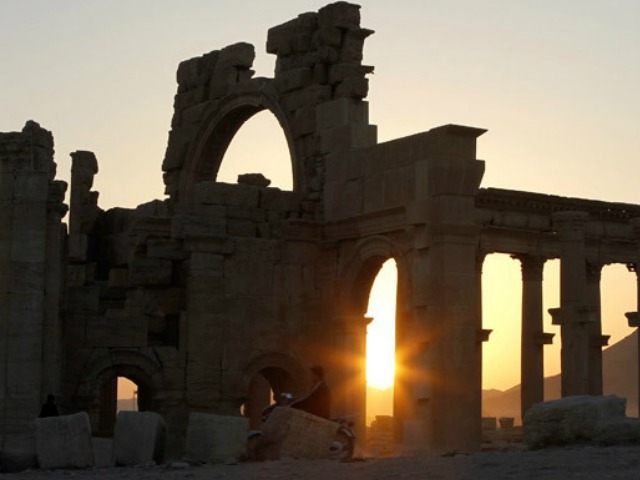The Islamic State (ISIS/ISIL) is on the doorstep of Palmyra, another UNESCO World Heritage Site in Syria. Officials warn if ISIS is not stopped, they will destroy another important historic city as they expand the caliphate.
“Dozens of the regime’s army and the allied militia forces (mainly the National Defense) were reportedly killed and dozens others wounded,” explained civil rights activist Bassam al-Dairi. “The IS hardline group announced Wednesday evening taking a full control of Sikhna city and advanced in the suburbs of Palmyra.”
Palmyra, 134 miles north of Damascus, is considered an oasis, surrounded by beautiful palm trees. The city first appeared in record in 2000 BC, but became very important under the control of the Roman Empire:
It grew steadily in importance as a city on the trade route linking Persia, India and China with the Roman Empire, marking the crossroads of several civilisations in the ancient world. A grand, colonnaded street of 1100 metres’ length forms the monumental axis of the city, which together with secondary colonnaded cross streets links the major public monuments including the Temple of Ba’al, Diocletian’s Camp, the Agora, Theatre, other temples and urban quarters. Architectural ornament including unique examples of funerary sculpture unites the forms of Greco-roman art with indigenous elements and Persian influences in a strongly original style. Outside the city’s walls are remains of a Roman aqueduct and immense necropolises.
ISIS constantly wipes history off the map because they feel these places promote “idolatry.” Maamoun Abdulkarim, Syria’s director-general of antiquities and museums, asked the United States to target ISIS before they reach Palmyra. He said “it will be a human catastrophe” if ISIS conquers Palmyra and they will definitely demolish “the temples, ruins and tombs.”
Militants destroyed three cities, including two UNESCO sites, in Iraq over one weekend in March. Hatra in northern Iraq was one of the first to go. Kurdish official Saeed Mamuzini claimed witnesses saw the militants “carrying away artifacts from Hatra as early as Thursday,” just two days before they destroyed the city.
“ISIS stole the ancient gold and silver coins, which were used by the Assyrian kings and were stored in the city,” he said.
Hatra became a UNESCO World Heritage Site in 1985. The organization condemned the demolition of the historic city.
“The destruction of Hatra marks a turning point in the appalling strategy of cultural cleansing under way in Iraq,” stated UNESCO head Irina Bokova.
Islamic State militants also destroyed the Assyrian city of Nimrud, located just south of Mosul in Iraq. Suzanne Bott, the heritage conservation project director for Iraq and Afghanistan in the University of Arizona’s College of Architecture, Planning and Archaeology, said Nimrud is one of the more valuable cities in world history. It is one of the Assyrian capitals “that practiced medicine, astrology, agriculture, trade and commerce, and had some of the earliest writings.”
Khorsabad was the third city to fall over that weekend. Assyrian King Sargon II resided in the city between 717 and 706 BC. It is also “one of three cities that served as a capital during the empire’s reign,” but abandoned after Sargon passed away in 705 BC.
ISIS destroyed numerous tombs, shrines, churches, and libraries in Iraq in the past year. They claim these places must be destroyed, but they first loot the museums and historic sites of priceless artifacts to sell on the black market. Experts claim the antiques made the militant group billionaires.

COMMENTS
Please let us know if you're having issues with commenting.